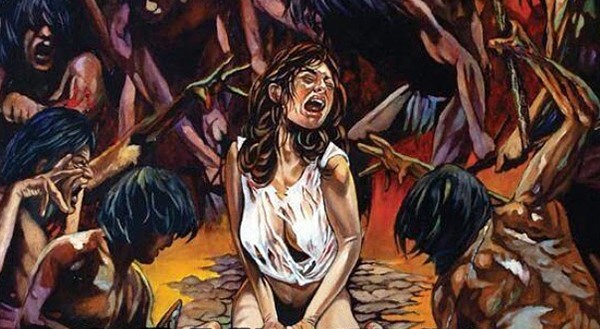American Night, 2021.
Written and Directed by Alessio Della Valle.
Starring Jonathan Rhys Meyers, Paz Vega, Emile Hirsch, Michael Madsen, Jeremy Piven, Maria Grazia Cucinotta, Mara Lane, Marco Leonardi, Fortunato Cerlino, Manal El-Feitury, Anastacia, Leart Dokle, Marc Fiorini, Paudge Behan, Owen Davis, Annabelle Belmondo, David Kirk Traylor, Lorenzo McGovern Zaini, Aaron Stielstra, Lee Levi, and Riccardo Cicogna.
SYNOPSIS:
A neo-noir set in New York City’s corrupt contemporary art world where the art dealer John Kaplan and the ruthless head of New York’s mafia, Michael Rubino, fight for money, art, power, and love.
Michael Rubino (Emile Hirsch, calm and collected until the script requires him to hilariously ham it up) is the son of a powerful New York Mafia boss who has just inherited rulership following his father’s death, with whom he had a complicated relationship. His interests lie elsewhere, as he is introduced splashing different colors of paint over a canvas, filling it with bullets. Whether it’s art or not, there’s at least a unique intersection here in writer and director Alessio Della Valle’s American Night.
The script is also a disjointed and twisting mess when it comes to telling an entertaining story within that dynamic of art and crime. For the first 30 minutes, American Night introduces various key players orbiting trying to secure a famous Marilyn Monroe painting done by Andy Warhol. This is done inside a bar where most characters convene, except once a bloody shootout erupts, Alessio Della Valle rewinds to the beginning of that scenario for a new perspective twice. The result is listening to the same tryhard dialogue (this movie desperately wants to exude a Quentin Tarantino kind of cool, but can’t, considering its characters might as well be dry paint or inexplicably silly) and jukebox tunes leading to slightly new information that doesn’t matter because the narrative fails to grasp attention.
From there, American Night settles back into chronology, diving into the backstory of artist John Kaplan (Jonathan Rhys Meyers), struggling to keep his gallery afloat alongside his art curator girlfriend Sarah (Paz Vega). There are also flashbacks within flashbacks, showing their start in the community, including some sex involving painted bodies. It’s another element that I’m not sure whether to laugh at or at least applaud the filmmakers for having some creativity and commitment to the art world backdrop. Nevertheless, this section does drag on (Michael Madsen makes an appearance for some threats), explaining that John is in a tough spot financially and creatively. Its purpose is also plain and could have been accomplished without dedicating an entire second act to it (and without detours to nightclubs so a musician that sings the theme song of the movie can have her own pointless scene).
One would think a 2-hour crime epic allotting equal time towards a head mobster and artist would come away succeeding at making both characters likable to an extent. Mainly so that when the final bits of scheming and plotting come together for acquiring the stolen painting, arrive with complexity has to who we want to see live and die. Somehow, despite spending over an hour trying to paint these characters as more than generic cardboard cutouts of the genre, American Night reaches a simple third act that is so formulaic and basic one can’t help but wonder how or why anyone thought it was necessary to stuff up the length of the first two acts this much.
Aspects of violence and sexuality are also gratuitous (most women characters exist to bare all in the background, become damsels in distress, or take graphic headshots caught in the crossfire of action scenes). However, the oddest element of American Night is easily Jeremy Piven’s stuntman Vincent, a friend of John also in need of money. Through a series of winding events I won’t explain here, it’s clear he is the one unknowingly in possession of the painting, portraying a well-meaning but bumbling fool failing at nailing his stunts for an Asian flick he is working on. Following this, he frequently listens to Bruce Lee’s quotes trying to be “like water” one day.
Everyone is set on a colliding path as a Mafia boss is conflicted on how he wants to rule and the place art has in his empire, stopping at nothing to obtain his stolen Marilyn Monroe painting. Nothing about it is thrilling, but Emile Hirsch is aware not to take any of this too seriously, especially during the goofy climax involving scorpions and a shaven head. Still, Alessio Della Valle strives for style, gritty suspense, and colorful characters yet achieve something as confused and boring as randomly splashing paint everywhere. The bullet holes in the art might as well symbolize Valle himself shooting American Night dead in its tracks.
Flickering Myth Rating – Film: ★ ★ / Movie: ★ ★
Robert Kojder is a member of the Chicago Film Critics Association and the Critics Choice Association. He is also the Flickering Myth Reviews Editor. Check here for new reviews, follow my Twitter or Letterboxd, or email me at MetalGearSolid719@gmail.com















